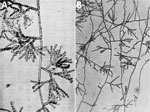Disclaimer: Early release articles are not considered as final versions. Any changes will be reflected in the online version in the month the article is officially released.
Volume 31, Number 11—November 2025
Etymologia
Cladophialophora carrionii [kladˊ-ō-fī-əl-ō-for-ə karˊ-ē-ō-nē-ī]
Suggested citation for this article
Cladophialophora carrionii is a black fungus that causes chromoblastomycosis. The fungus was first reported in 1946 as Fonsecaea pedrosoi var. cladosporium. In 1954, mycologist Alfonso Trejos named this chromoblastomycosis agent Cladosporium carrionii n. sp. (Figure). Later, molecular phylogenetic analysis and morphologic traits (cladosporioid anamorphs and phialidic synanamorphs) supported its current placement in the genus Cladophialophora.
The term Cladophialophora is derived from the Greek words klados (branch) and phiala (flask or bottle) and the suffix phora, which means bearing or carrying, emphasizing that these structures produce and harbor the fungal spores. The specific epithet carrionii is in honor of the charismatic Puerto Rican mycologist Prof. Dr. Arturo I. Carrión, renowned for his contributions to medical mycology, particularly in the taxonomy and clinical understanding of dematiaceous fungal pathogens. Therefore, the full name Cladophialophora carrionii means a black flask-shaped fungus with branched conidia chains, named in mention to doctor Carrión.
References
- Bensch K, Braun U, Groenewald JZ, Crous PW. The genus Cladosporium. Stud Mycol. 2012;72:1–401. DOIPubMedGoogle Scholar
- de Hoog GS, Guého E, Masclaux F, Gerrits van den Ende AH, Kwon-Chung KJ, McGinnis MR. Nutritional physiology and taxonomy of human-pathogenic Cladosporium-Xylohypha species. J Med Vet Mycol. 1995;33:339–47. DOIPubMedGoogle Scholar
- Simson FW. Chromoblastomycosis; some observations on the types of the disease in South Africa. Mycologia. 1946;38:432–49. DOIPubMedGoogle Scholar
- Trejos A. Cladosporium carrionii n. sp. and the problem of Cladosporia isolated from chromoblastomycosis. Rev Biol Trop. 1954;2:75–112.
Figure
Suggested citation for this article: Moraes D, Bailão AM, Silva-Bailão MG. Cladophialophora carrionii. Emerg Infect Dis. 2025 Nov [date cited]. https://doi.org/10.3201/eid3111.240204
Original Publication Date: November 25, 2025
Related Links
Table of Contents – Volume 31, Number 11—November 2025
| EID Search Options |
|---|
|
|
|
|
|
|

Please use the form below to submit correspondence to the authors or contact them at the following address:
Mirelle Garcia Silva Bailão, Universidade Federal de Goiás, Avenida Esperança s/n ICB2, sala 217, Laboratório de Biologia Molecular, Goiânia, Brazil
Top